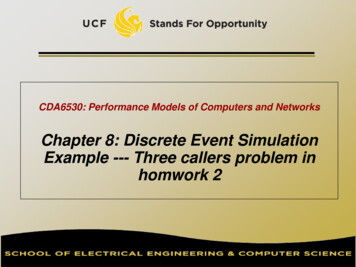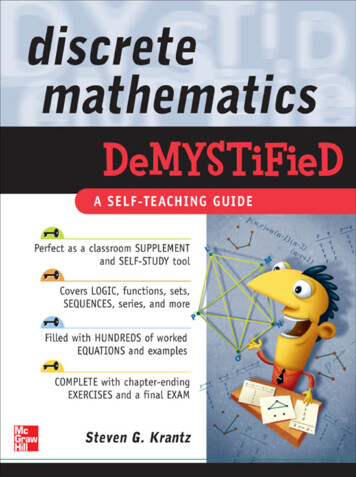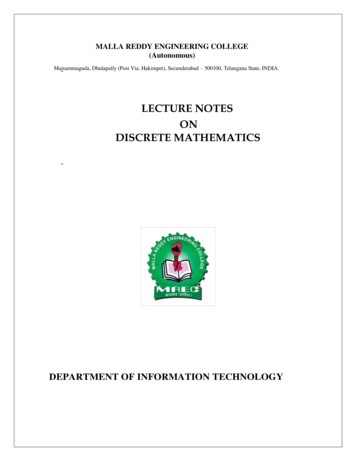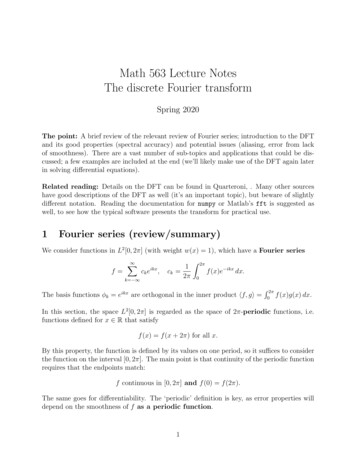
Transcription
CDA6530: Performance Models of Computers and NetworksChapter 8: Discrete Event SimulationExample --- Three callers problem inhomwork 2
Problem Description Two lines services three callers. Each caller makes callsthat are exponentially distributed in length, with mean1/¹. If both lines are in service by two callers and thethird one requests service, the third caller will beblocked. A caller whose previous attempt to make a callwas successful has an exponentially distributed timebefore attempting the next call, with rate . A callerwhose previous call attempt was blocked is impatientand tries to call again at twice that rate (2 ), alsoaccording to exponential distribution. The callers maketheir calls independent of one another.2
Analysis Results Steady state prob: ¼¼Q 0¼1 1 3Matlab code:Q [ ];Pi zeros(1, 6);Q m [Q(:, 1:5) ones(6,1)];B [0 0 0 0 0 1];Pi B * inv(Q m);
Simulation based onMarkov Model4
Pre Simulation Strictly refer to the state transition diagram Remember current state: currentStateDetermine next state: nextStateThis is a continuous-time Markov ChainMethod #1: State duration time (for the transition node in the right): Exp. distr. with rate ( ¹ )Determine the next transition event time¹At the time of transition event: Use discrete r.v. simulation method to determine nextState: Transit first path with prob. of /( ¹) Transit second path with prob. of ¹/( ¹)5
Pre Simulation Method #2: 1 Should jump to 1 by exp. distr. Time with rate find jump time t1Should jump to 2 by exp. distr. Time with rate¹ find jump time t2If t1 t2, the actual jump is to 1 at even time t1If t2 t1, the actual jump is to 2 at even time t26¹2
Pre Simulation Events: Event List: EL { ttran }: time of the next transition eventSimpler than queuing systemsOutput: Transition out from currentState to nextStateTran(i): event time of the i-th transitionState(i): system’s state after i-th transitionTermination condition: N: # of transitions we simulate7
SimulationSet stateN, initState, N, lambda, mu, QcurrentState initState; currentTime 0;for i 1:N, % simulate N transitions% first, simulation currentState during time (next event time)% Given that we know the Markov model and the Q matrixoutRate - Q(currentState, currentState);Tran(i) currentTime - log(rand)/outRate; % exp. distr. with rate of outRate% next, determine which state transits to?U rand;vector Q(currentState,:); vector(currentState) 0;for j 1:stateN,if U sum(vector(1:j))/sum(vector),nextState j; break;endendState(i) nextState;currentState nextState; currentTime Tran(i); % prepare for next roundend8
Post Simulation Analysis Objective: Compute Pi based on simulationPi(k) time spent in state koverall simulation time Overall simulation time Tran(N)Time spent in state k: Time(k)Time zeros(6,1); Time(initState) Tran(1);for k 1:6,for i 1:N-1,if State(i) k,Time(k) Time(k) Tran(i 1) - Tran(i);endendend9
Simulation ulation11.5 22.533.544.555.511.522.533.546N 5000N 100Shows that our simulation isconsistent with analyticalresult104.555.56
Realistic SimulationWith physical meaning11
Problem for the Simulation Above The simulation actually simulatescontinuous-time Markov Chain only Only based on Markov modelThe simulation does not really simulate thephysical world eventsThree callers? What’s their status? Two service lines? More accurate & realistic simulation Simulate the physical entitiesactions/behaviors/events12
Pre Simulation What physical entities should we consider? There are two types of entities Should directly correspond to physical entitiesShould uniquely define system statusTwo service linesThree callersIf we do not care which service line isworking We should treat three callers as simulationnodes13
Pre Simulation Each caller’s data: status: ‘patient’, ‘impatient’, ‘calling’ Caller[3]; each entry ‘P’ or ‘I’ or ‘C’nextT: event time for its next action What “next action” could be? Finishing phone call Making phone call attempt When current status is ‘calling’When current status is ‘idle’ or ‘impatient’Event list: Each caller only has one next event/actionEvent list: EventList[3] Three nodes’ next action timeWe do not really need to save nextT in caller data since it issaved in EventList14
Pre Simulation Next event: the smallest time in EventList Suppose it is EventList[k] Means caller k does the next action firstUpdate system at this time EventList[k]Move simulation time to this event time Check caller k: what’s its action? Regenerate the next event time nextT for caller k Based on its next status: calling? Patient? Impatient?We need to know the status of those two service lines inorder to determine this serveLineNum: # of lines that are usingUpdate EventList[k] nextT15
Pre Simulation Update output data: Tran(i) EventList[k]State(i): system’s state after this node action In order to compare with analytical resultsIf we care about each caller’s behavior:Tran(i) EventList[k] ActCaller(i) k The k-th caller acts at time Tran(i)CallerState(i) Caller(k) k-th caller’s state after the i-th eventThe other callers do not change their state after this event16
Simulation Pseudo CodeInitialize N, \lambda, \mu, State[], Tran[]Initialize initState and Caller[3]; currentTime 0;Initialize EventList[] (use corresponding distribution to generate)For i 1:N,Find the smallest time tick in Eventlist[] index is k% caller k’s action is the event we simulate nowcurrentTime EventList[k];Update caller k’s status;Update how many phone lines are usedGenerate caller k’s next action time, assign to EventList[k]% Update output dataTran(i) currentTime;State(i) ? (case statement to decide based on state definition)End17
State(i) ? (case statement to decide based onstate definition)E.g.: [C,C,I] state 3[I,C,C] state 3[P,C,I] state 4 18
Simulation Compared with 0.150.10.05011.522.533.54N 1000194.555.56
Conclusion The realistic simulation uses minimal amount ofknowledge of statistical analysisRealistic simulation directly simulate real worldentities actions and behaviorsThe model-based simulation is still useful Better than no simulationApplicable for all systems described by one modelCan study system’s performance when there is noanalytical resultsSometime realistic simulation is too complicated ortake too long to doWe need to decide which simulation to conduct20
The realistic simulation uses minimal amount of knowledge of statistical analysis Realistic simulation directly simulate real world entities actions and behaviors The model-based simulation is still useful Better than no simulation Applicable for all systems described by one model Can study system's performance when there is no










